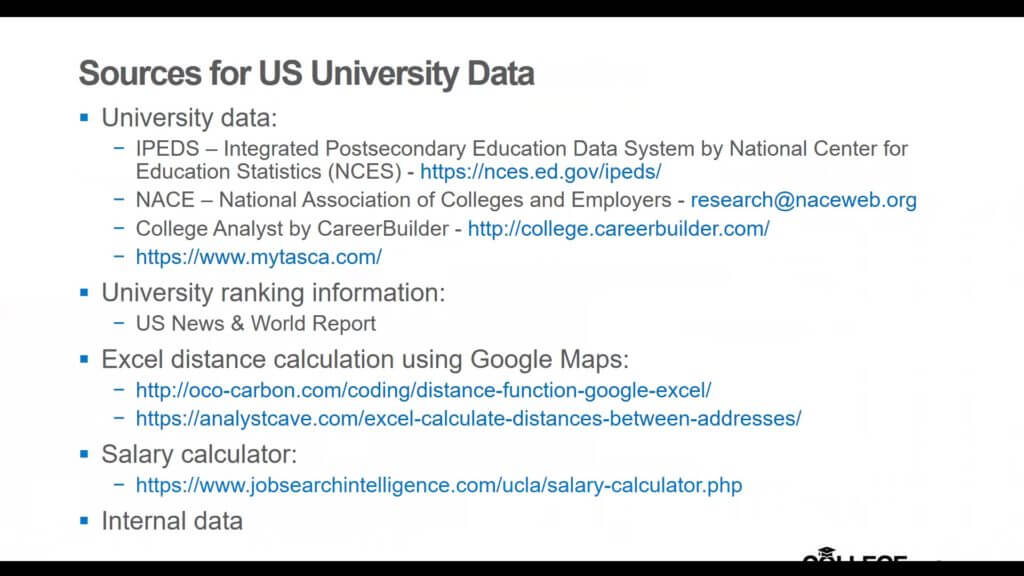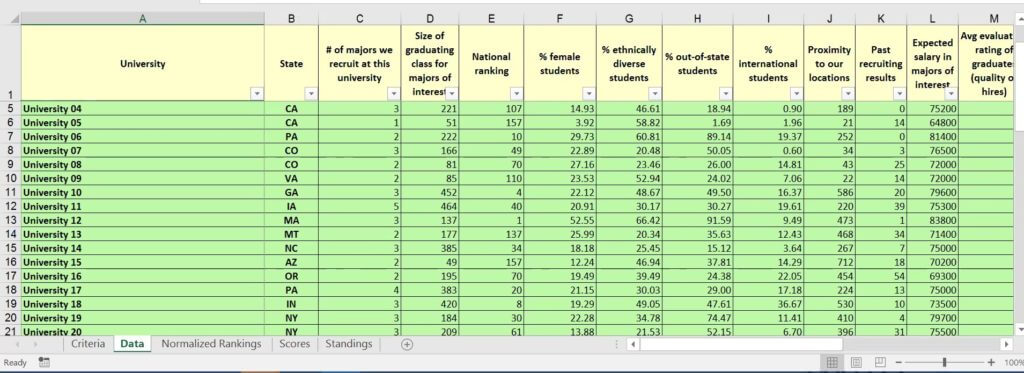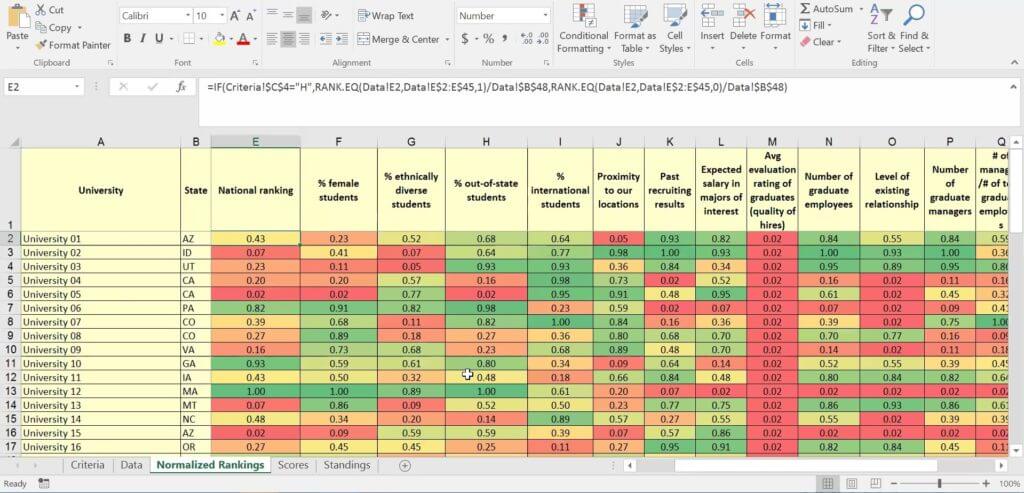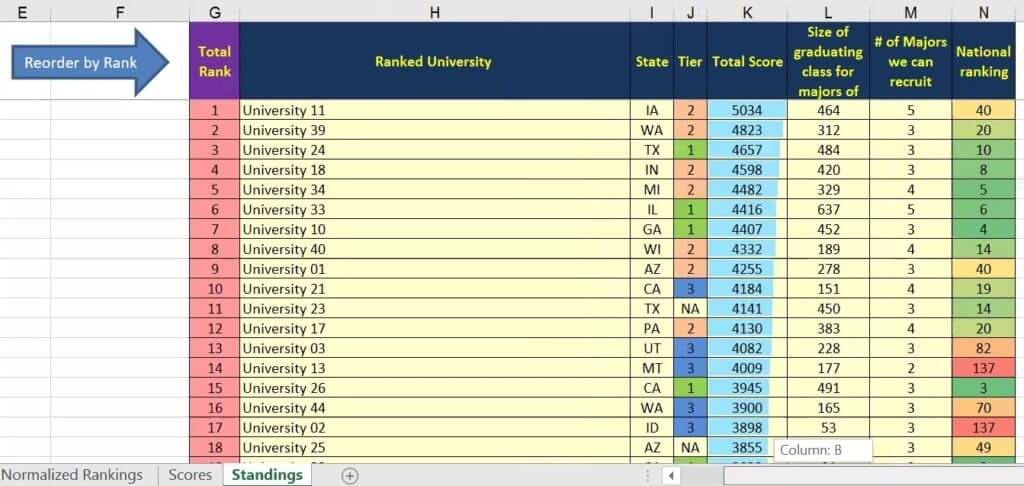Advice for Employers and Recruiters
A data-driven university selection approach: You can too!
At Micron Technology, Dmitry Zhmurkin uses a fantastic method for basing their university relations decisions on data. Zhmurkin is their University Relations Program Manager, and his method helps them decide whether to visit a campus and work with career services, or whether to recruit virtually. College Recruiter’s president and founder Steven Rothberg recently spoke with him about his methodology and said that Zhmurkin “just greatly improved the college recruiting practices at probably dozens, maybe hundreds of organizations.”
Want to know the secret formula? Below we summarize Zhmurkin’s presentation, including a description of his methodology.
You can also check out Dmitry Zhmurkni’s full presentation, walking through his methodology, and download Zhmurkin’s slides here.
Why use data in university relations
There are good reasons for using a precise method to select your colleges and universities. First, says Zhmurkin, “every company is different and every company has different ways of looking at candidates, and every company has different things that matter to them. Therefore, developing your own way of selecting universities really helps your organization because you know what you’re looking for.”
To Zhmurkin, the reason to base these decisions on data is that “it allows us to remove emotions from the university selection process. Everybody has an opinion on how recruiting should be done. And when it comes to executives, let’s be honest, a lot of them have thoughts about what universities the company has to be recruiting from.” (And might those universities, asks Rothberg, coincidentally be their alma maters?)
A great benefit to collecting data on your schools is that it gives you the ability to push back on the status quo. “The data will really position you as an expert in your organization and people will eventually start listening to your opinion,” says Zhmurkin. The benefit increases over time. “Year after year, you acquire more data as you go, and you’ll become more precise in your university selection. You will build on your knowledge of those universities. And therefore your recruiting efforts of these schools will become significantly better with time.”
Zhmurkin has seen his method work very well, although he points out that his exact methodology may not be perfect for everyone. He’s worked as a University Relations Manager at three employers, and has consulted with additional companies where he applied this methodology. “The results were actually very, very significant. In all the companies that I worked for we were able to reduce the list of universities that the company was going to recruit from, and instead we became more strategic with the universities. We knew exactly why we were recruiting from these universities. Every year our results were getting better and better. We became targeted who became very focused.”
How to select universities
“It all begins with really understanding what’s important for your company,” says Zhmurkin. “List out your possible criteria, and you don’t have to use all of them.” In the image below, column A lists the selection criteria that Zhmurkin used at one employer. You also must decide how important the criteria are in relation to each other. That’s what you see in column B below. According to Zhmurkin, “you basically assign each criteria a weight. And this is going to be a multiplier that will be used further down the road once data is collected.” In column C below, you see an indicator of how to sort the data. As an example, says Zhmurkin, if a school’s national ranking is one of your criteria, “the lower the number, the better.”
Other criteria to consider might be student diversity, and the percentage of out-of-state students. Looking at the out-of-state number can give you a sense of students’ mobility. “The assumption is that students who decided to go to school to a different state are more open to relocating to your organization,” says Zhmurkin. Yet another criteria might be promotability, that is, the conversion of grads into managers.
Rothberg suggests another criteria. Measuring how long the hires stay with your organization is essentially a measure of productivity. “You might recruit Cindy, and the cost-per-hire for Cindy might be half of what it costs to hire Sally. But if Cindy leaves you after six months and Sally is with you for five years, guess who was the better hire? So if employers are only looking at cost-per-hire, they may end up with a lot of churn. Productivity is the real goal.” At College Recruiter, says Rothberg, “we’re seeing a huge shift in the last two years of a rapidly growing minority of employers that are looking at productivity as a hiring measure. That’s really encouraging. A lot of employers stop recruiting at some of the schools they’ve been going to for forty years because they’re finding that those people are great but they leave. In their second and third tier schools, those employees are staying for five, 10, 20 years, and so the productivity is much better.”
Also read: The average cost-per-hire for on campus recruiting is $3,582
Zhmurkin adds that it’s important to consult your hiring managers as you develop the right criteria. “Somebody might say, well we don’t really care how far the universities are from our offices, we are still willing to take those trips.” In that case, just assign a low weight to that criteria, or remove it altogether. “It’s a work in progress and the more you use this methodology, and the more you talk to executives or hiring managers, the better data you will have.”
The idea is that you establish some criteria, and that everybody has to be somewhat on board with your selection criteria.
The fun part: Getting the data
Once you have established your criteria, that’s when Zhmurkin says the fun part begins. Now you go and get the data. Where, you ask?
In the image below, Zhmurkin lists multiple sources of data. A lot of it comes from the universities. All colleges and universities are required to provide data to the federal government, so that’s the good news. The bad news is that these systems are “terrible and not user friendly,” says Zhmurkin. He recommends using other sources too. “You can submit a request to the National Association of Colleges and Employers (NACE) and they will do it for you,” but be precise in what you’re requesting, otherwise you might get something you don’t want. Other sources of data are College Analyst by Career Builder (which requires an annual subscription), Mytasca, and Job Search Intelligence. “Whatever you decide to use, just be consistent and use the information from the same source.”
Your internal data is critical too. “Track your employees, track your success on campus, track your employee performance after they joined the company and so forth,” says Zhmurkin. “The more internal data you have, the more precise you’re going to be selecting universities.”
In the next image, you can see how Zhmurkin populates the data. In the column headers you see the selected criteria. In column A is a list of universities, and your data sources–be that Job Search Intelligence, Mytasca, internal data, etc.–will populate your spreadsheet. For example, you can find the number of students graduating from any major. For national ranking, Zhmurkin looked to US News and World Report.
Once you’ve populated your data, start crunching the numbers. In the next two images, notice that all the numbers are between zero and one. The reason, says Zhmurkin, “is because it’s important to normalize the data so that all the data that you have collected is now on the same order of magnitude.” When you normalize it, you make sure that the highest number means that’s the best.
Take the normalized value and multiply it by its assigned weight. To get each school’s total score, Zhmurkin multiplies it by 100, “just so that the numbers are round and large.”
Zhmurkin says, “the key is that each value from the normalized ranking tab is now multiplied by the corresponding weight, and then if you sum that across you get the total score.” (Confused? Watch this part of his presentation at minute 25:00.)
Now sort and rank all your schools
Next, sort your schools by total scores. Your sorted list makes it easy to rank them. And voilà, you have your final result!
Zhmurkin acknowledges that there could be other things to keep in mind, despite a high total score. For example, if a certain school is ranked highly but “there’s only one major we’re recruiting for, there is a decision that you have to make.”
Using this methodology, Zhmurkin says that his organization spends more time and money on the schools that are ranked highest. “We used tiers, so tier one is our top universities.”
Zhmurkin encourages others in university relations to “present this to executives, steering committees, hiring managers. Have a conversation about which universities you should engage for your recruiting efforts.”
Rothberg adds that it’s also important to bring this data to career services too. “If they’re trying to convince you to come to their school, but they’re number 42 and you’ve only got money to go to 20 schools,” it’s not that you don’t like them but your data doesn’t justify spending the money.
One key point to take away is the importance of using real data, “not emotions or past results but real data about the university,” says Zhmurkin. “As you do it year after year and apply a similar methodology, your internal data will become better, and the quality of this analysis will become progressively better, and therefore you will become more precise and more strategic in selecting universities that work for your company.”
After he spent the time brainstorming and discussing the criteria, it took Zhmurkin two hours to build his spreadsheet. For those who feel less skilled in Excel formulas, Rothberg made a great suggestion: “This would be a fantastic project for a statistics intern.”




